When it comes to planners, and we mean physical, hold-in-your-hands, real-paper planners, there are so many options that it’s easy to go with no option at all. But truthfully, by giving into analysis paralysis, you’re missing out on the huge benefits of going paper—namely, increased productivity, better organization skills, a happier life, and so on. In order to make this decision easier for you, we’re doing a this vs. that series, planner style. Each round will compare the pros and cons of two of the best planners of 2018, so you can make the decision that works for you and your needs. Ready for round one? It’s Passion Planner vs. Panda Planner Weekly*.
Before we get started, let’s take a look at what we’re reviewing. And FYI, we’re doing a deep dive, so you know how they really work. Here’s what we’ll cover:
- The products we reviewed
- The reasons we selected them
- A general overview of their features
- Price
- Design
- Monthly approach
- Weekly approach
Panda Planner and Passion Planner Review: The Basics

Both Passion Planner and Panda Planner will set out a path for you to tackle your everyday tasks, as well as your long-term goals. They’ll also help you prioritize what’s important and plan out your days, weeks, and months. What’s the difference between these productivity tools? Well, it turns out, quite a bit. It just depends on what you’re looking for and what works best for you. So part of this is an activity in knowing yourself.
Here are the specific products we reviewed:
What’s Special About These Two Planners?

Before we jump in, you should know one thing: These are not your average planners. The ones you can pick up at the store have lots of blank space and little direction. While that works for some people, others need more structure, especially if they’re struggling to get organized, work through a mental health issue, or just recognize the good in their lives. That’s where these planners really come through. Both Passion Planner and Panda Planner Weekly give you the structure to stay focused, get organized, and prioritize your goals. But each has their own unique way of doing so.
In our opinion, one of the key differences between the weekly versions of the planners involves your end-goal. Are you looking for a place to turn dreams into reality? Or are you in need of stress relief, work-life balance, and concrete, research-backed ways to build your happiness? To help you through these questions, let’s take a look at some of the planners’ basic features and intentions.
Passion Planner
- Takes you through the process of breaking down your dreams into manageable steps
- Uses a specific goal-planning strategy called, “passion planning.”
- Helps you effectively turn your aspirations into concrete, measurable goals
- Focuses on positivity through weekly and monthly prompts
- Helps you focus on balancing your life through principles of positive psychology and neuroscience
- Encourages people to consider their whole selves when planning out their time
- Focuses on positivity through daily, weekly, and monthly prompts
- Considers happiness a critical part of productivity
Price & Design
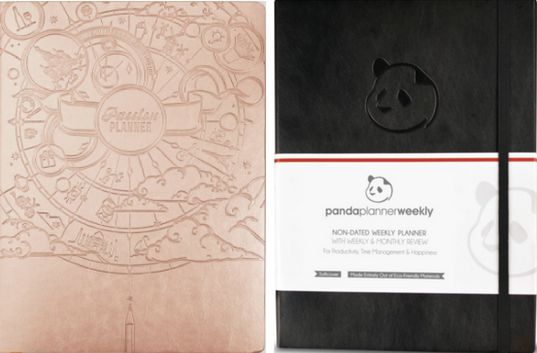
Passion Planner
- Price: The weekly Passion Planner we used for this review is $35.00, plus shipping and handling, though the price depends on the color to some extent.
- Cover design: The rose gold option we chose included an engraved cosmic design on the cover. If aesthetic is important to you and encourages you to stick with it, Passion Planner gives you plenty of options.
- Internal layout: The Passion Planner is divided into three main sections: Monthly Layouts, Weekly Layouts, and 40+ Blank and Grid Pages for creative space. There’s also a folder flap at the end of the planner to stick in pictures or other papers.
- Price: Panda Planner Weekly wins the price category: It’s only $25.97 (add shipping and handling).
- Cover design: This version only comes in one color: black, though the classic and pro versions come in other colors (e.g., orange, cyan, and purple). It also includes an engraved Panda on the cover for a simple, but classic design.
- Internal layout: Panda Planner is divided into two main sections: Monthly Section and Weekly Section. (There is technically a Daily Section as well, but it’s interwoven through the weekly one.) There are blank pages dispersed within the weekly section for creative space. The last five pages of the journal include a blank note section, as well. This planner also has a folder flap. One additional feature? It has three ribbons that allow you to easily switch between the weekly, monthly, and notes sections of the planner. Passion Planner only has one.
Getting Started: The Passion and Panda Processes
Passion Planner
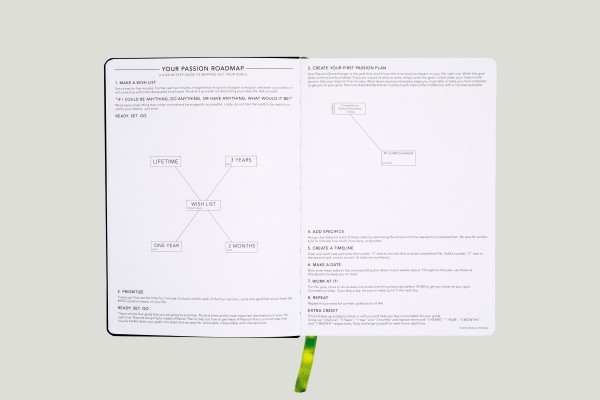
The Passion Planner starts you off by revealing their “passion planning” process. It’s a step-by-step method to turn your dreams into reality through actionable strategies. The goal is to help you prioritize what you really want to do in order to live your best life. As you go through the process, you’ll also get an explanation of the psychology behind “passion planning”. Once you start using your planner, you’ll know the specific and critical steps to reach your ultimate goal. This passion plan gives you the know-how to start mapping out your goals effectively.
Want a little more help? The Passion Planner Youtube channel teaches you a few fun ways to use your planner.
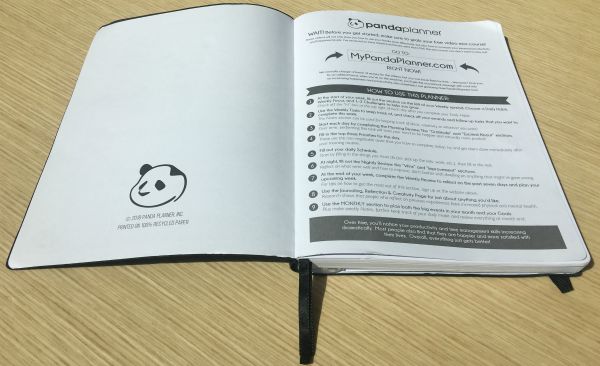
Panda Planner Weekly opens with a one-page introduction giving you the basic steps to get started with the planner. It also invites you to access its free video mini-courses at MyPandaPlanner.com, a membership site exclusively for Panda Planner users. This supporting content will give you guidance on topics like goal-setting, happiness, positive psychology, anxiety, stress, and gratitude. In other words, it tells you why the planner includes certain activities and sections, based on science, and helps you get the most out of it.
Now that we’ve reviewed how to get started, let’s take a look at each section in more detail.
Monthly breakdown
First order of business when using your planners? Scheduling out your month. Here’s how each planner takes on your next 30 days.
Passion Planner features: Monthly
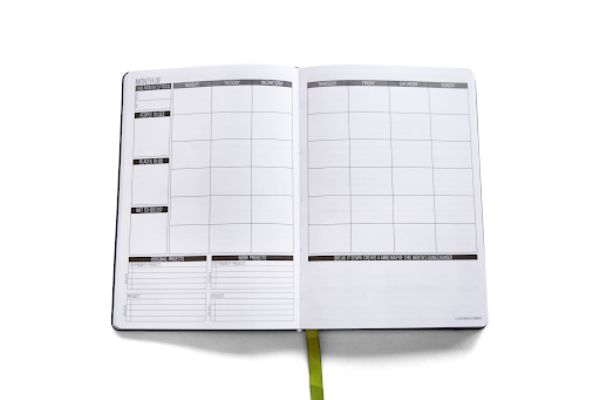
The Passion Planner has four pages dedicated for each of the 12 months. The first two-page spread (above) includes:
- A monthly calendar
- A space to note the month’s focus
- A section for people you want to see this month
- A section of places you want to go
- A not-to-do list
- A space to prioritize your personal and work projects
- An area for to you to indicate a due date, which helps you give your goals a deadline
- A blank space to map out your month’s gamechanger, an element of “passion planning”
Once your month is up, you can take some time to review it in the second two-page spread. By keeping track of your progress and growth, you can gradually improve your productivity month-by-month. The second two-page spread includes:
- Reflection pages with questions such as, “What was the most memorable part of this past month?” and “How are you different between this past month and the month before it?”
- A short, end-of-the-month checklist to highlight your accomplishments and strategize for the upcoming month
The Passion Planner also has two bonus sections:
- A “mid-year passion roadmap,” which aims to reset and renew your passion plan.
- An “end of the year reflection,” which helps you realize how you changed in the past year.
Panda Planner Weekly features: Monthly
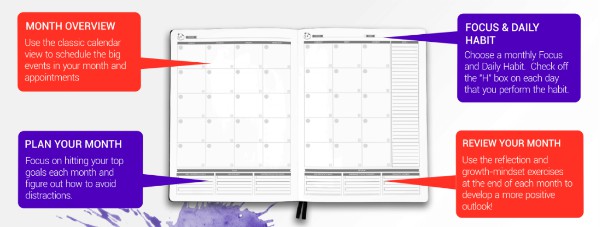
Panda Planner’s monthly layout in the weekly version is only a two-page spread (above). Here’s what that includes:
- A monthly calendar
- A monthly focus and habit to build: Every day you do your daily habit, you can tick the “H” box. This uses the “Don’t Break the Chain” technique to create momentum with your habit.
- Space to plan your month when it begins with subsections for:
- Jotting down three goals
- Explaining why you chose those goals, which highlights their importance in your life (based on this research on goal-setting theory)
- Describing distractions you need to avoid to accomplish those goals (based on this research on elements of goal-setting)
- Space to review your month when it ends with subsections for:
- Noting your month’s wins, giving you positive feedback on your progress
- Sharing your insights from the month
- Selecting areas for improvement, providing critical and constructive feedback for moving forward
Weekly breakdown
Now that we know how each planner sets up your month, it’s time to get into the nitty-gritty of your week-to-week. Let’s take a look at their approaches.
Passion Planner features: Weekly
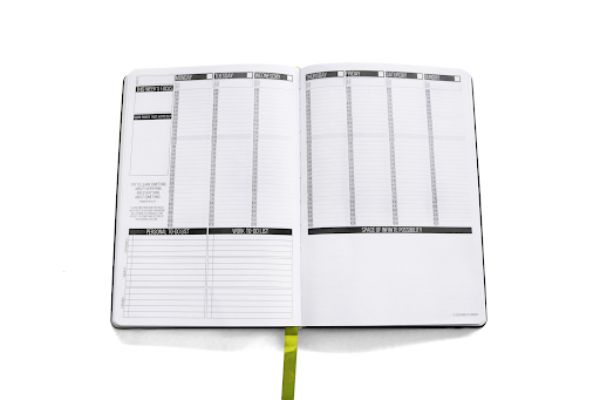
The Passion Planner’s weekly layout (above) is broken down by days and then by hours. Here’s what it includes:
- Space for you to indicate your focus for the week that you fill out before any individual days
- Inspirational quote
- Place to jot down any challenges you’re experiencing
- Weekly to-do list that is divided into the following sections:
- Top priorities
- Priorities
- Errands
- The amount of time you’d like to spend on each task
- Work to-do list that is divided into the following sections:
- Top priorities
- Priorities
- Errands
- The amount of time you’d like to spend on each task
- Short space for notes and further passion planning
- Section for you to focus on the positive called, “good things that happened”
Panda Planner Weekly features: Weekly
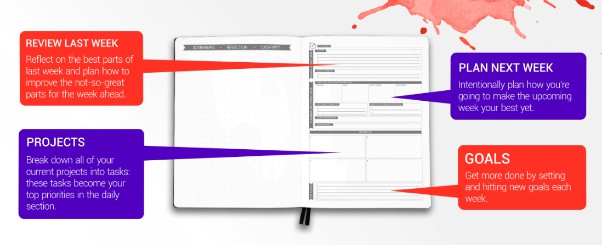
Panda Planner’s weekly section is more detailed. Every week, Panda Planner Weekly trains you to review your prior week and plan the next. The weekly section consists of four, repeated pages. The first two pages help you review and plan, and the second two pages break down those plans into your week.
The first two pages contain:
- One page to journal, reflect, and be creative. This can help you brainstorm your projects and priorities for the week.
- One page to guide your weekly planning. The planning page includes areas to jot down:
- Your bigs wins from the past week and what you’d like to improve
- What you want to focus on in your personal, professional, and relational areas of your life (i.e., partners and friends/family). This helps you identify what’s important to you and bring focus to areas of your life that might be lacking.
- Four projects for the week.
- Your top five goals for that seven-day period.
The second two pages contain:
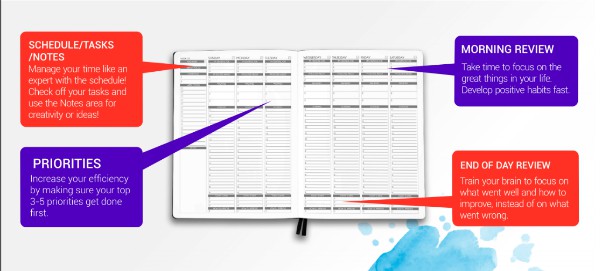
The second spread breaks down your week in a similar format to Passion Planner but has one key difference—science. The exercises and even number of spaces to fill out are based on behavioral science (e.g., habit-building) and positive psychology (e.g., happiness and gratitude). Here’s what those sections feature:
- A place for a positive habit you’re trying to build, such as exercise, meditation, journaling, etc.
- A designated space for your weekly focus. This can be on any part of your life—family, friends, or work. Just like the Passion Planner, your weekly focus is in a prominent position on the spread.
- A place to record two challenges that might get in your way of accomplishing your goals. It helps you identify your roadblocks so you can develop a plan to overcome them.
- A designated list of tasks for the week. The tasks on this list can be placed into the day-by-day breakdown, similar to that of the Passion Planner.
- A notes section for any ideas or thoughts that come up during the week.
Each day of the week is broken down into a few key elements:
- A gratitude exercise and “I’m excited about” section to complete in the morning.
- Your top three priorities for the day. These are the MUST-DOs to keep you moving toward your big goals.
- Hourly breakdowns that help ensure you have time planned for your top three priorities plus any other events of the day.
- An end-of-day review: Write down three wins of the day and one way you can improve.
Where Can I Get Creative?
Now that you’re familiar with the structure, let’s talk about where you can break away from it. In other words, places to get creative.
Passion Planner features: Free space
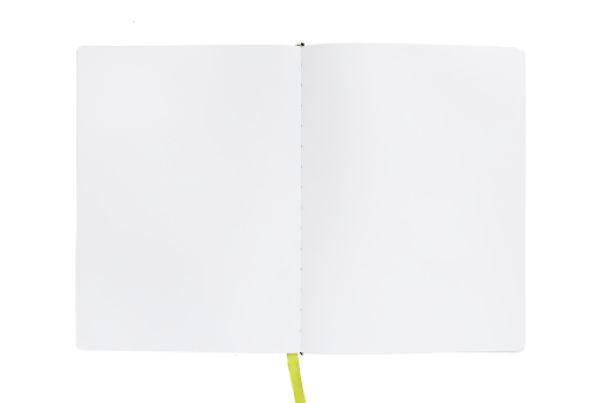
The Passion Planner gives you 40+ consecutive pages to get creative. Consequently, this is the planner for you if you want space to let your ideas freely flow without limitation. You can use the space to daydream about your life, passion plan, journal, reflect, or even just draw.
Panda Planner Weekly features: Free space
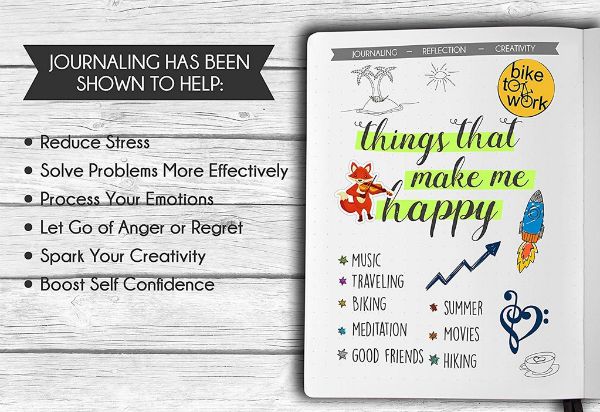
In contrast, Panda Planner Weekly’s creative space is scattered in single pages and small sections throughout the planner. To some, it might seem limiting to condense all your ideas onto just a single page each week. However, there are note pages at the back of the planner that give you a bit more room, but there are only a handful of them.
What’s better: Passion Planner or Panda Planner?

If you want to lead your life with productivity and with intention, both planners will help you do the job. But there are some differences. On the one hand, Passion Planner focuses on making big dreams happen by giving you a system for identifying key goals and then helping you break them down into actionable steps.
On the other hand, Panda Planner uses science to help you build positivity and gratitude for the life you already have while helping you get closer to the life you want. It does this by encouraging you to build balance in all areas of your life, helping you refocus your energy and emotions to improve way more than productivity.
Ultimately, the planner that works best for you comes down to your needs, goals, and understanding of how you operate. We hope this review gave you enough information to bite the bullet and join the world of paper planners. As you can see, there’s a lot more going on here than merely organizing your schedule. With the right tool, you can build a more meaningful life. And isn’t that what we’re all here for?
Your turn: Passion Planner or Panda Planner: What one would work best for you? Tell us what planner you picked and why in the comments below.
If you like this article you’ll also like One Simple Way to Increase Productivity at Work
*Positive Routines is affiliated with the team at Panda Planner. All opinions are the writer’s own, based on her experience using and reviewing the products.
Author: Nadia Chaudhry
Nadia Chaudhry is an SEO copywriter and content marketer. She’s all about growth in business and life. No surprise, she loves to write about personal development, productivity, e-commerce, and marketing. But first, pilates. Follow her on Twitter @NadiaChaudhry.

 Elizabeth A Hodgson says
Elizabeth A Hodgson says
August 6, 2018 at 8:56 pmLove the comparison of passion vs panda planner. Funny, but I compared the two prior to reading this. Ended up with panda planner for myself and passion planner for my 33 year old daughter. Very cool! I love my choice!!
 Chelsey Taylor says
Chelsey Taylor says
August 7, 2018 at 8:24 amThank you so much, Elizabeth! It’s certainly interesting to compare various features of the planners that are out there and figure out what one works best for you. It seems like you made the right choice for both you and your daughter, and we’re glad they’re working out. Thanks again!
 Fleur F says
Fleur F says
November 30, 2018 at 11:23 amI used the Passion Planner for the last 2 years but they no longer offer their dated smaller size, which fits in my purse. Two main goals for me in a planner, 1) fits in my purse 2) hourly appointments. 3) dated. So I turned to Panda this next year for 2019. Wait…they don’t offer a dated version (which bums me out), but by the time I looked over their product, I ended up with their larger weekly view. Yikes, I compromised on 2 on my priority list (!), but I am going to try it out for a year.
 Chelsey Taylor says
Chelsey Taylor says
December 3, 2018 at 9:11 pmThanks for the comment, Fleur! Let us know how it’s working for you.
 Sherry Mazza says
Sherry Mazza says
December 22, 2018 at 5:59 pmI searched thru so many planner reviews. I really wanted a clean (black and gray). Look. Happy planners are so busy I am free to use color pens if I want . The Panda planner seemed right for me but I had wanted the Pro. My husband ordered me the Classic and the size is just right I really appreciate the positive approach as I am often I’ll i also do not have to be concerned about dates
 Chelsey Taylor says
Chelsey Taylor says
December 22, 2018 at 6:42 pmThanks for the comment, Sherry! We’re so happy you found something that’s working for you. We all need a little more positivity in our days, so we’re happy the planner can help you get more of it. Thanks again and happy planning!
 Veni says
Veni says
December 25, 2018 at 4:16 amRe pricing, the Pamda Planner lasts for only 3-6 months so it might not be the most economical. Please consider looking into the pricing of panda and revising your article.
 Chelsey Taylor says
Chelsey Taylor says
December 25, 2018 at 4:57 pmThanks for the comment, Veni! You’re correct that the Panda Planner only lasts for 3–6 months, which will require you to purchase one mid-year. However, there are other perks that come along with the Panda that don’t exist with full-year planners. We’ll add a line to clarify. We hope people make the decision that works best for them, and we hope you will too. Thanks again!
 Desirae says
Desirae says
September 3, 2019 at 10:36 amThank you for the in depth review! I’m in my late 40s and have recently been diagnosed with inattentive ADHD. I’ve long railed against planners, calendars and lists for any number of reasons. And, any attempt to actually use them has failed miserably. I was chatting with one of my managers a few months ago, who just happens to have a degree in behavioral science, but doesn’t work in the field. She suggested a Panda Planner, picked one out that she felt might work best for me and ordered it for me on the spot, in blue. My ADHD brain needs something to hold my interest lol. I used it for a short time, and then, like other planners, forgot about it and then anxiety set in over starting again. As I learn more about ADHD and the inattentive subtype that I deal with, I’m learning to accept things about myself that I have been too stubborn to accept throughout my life. One of those things is that I simply cannot remember and recall everything I need to. Most people can’t, and most of us with ADHD especially so. Keeping a calendar and lists doesn’t show that I don’t care to remember, it’s just accepting that I don’t, won’t and flat out can’t. With that realization, I’ve been able to find some organizational solutions to keep my work desk reasonably clutter free, and my Panda Planner on a book stand, next to my computer monitor, open and readily accessible at all times. Getting my meetings and appointments down onto paper, and simple to do lists have been helping me stay more on track and relieving a good deal of stress, anxiety and depression. My co-workers appreciate it as well. They can now scan my work calendar online (yep, this requires and extra level of diligence on my part) and schedule meetings with me and be reasonably confident that I won’t have to frantically reschedule due to something I forgot I needed to do. As I read through articles on how to manage an ADHD brain, paper planners come up often with lots of recommendations. Having an in depth review like this one really helps with the analysis paralysis! In my case, I’m confident the Panda Planner is the right one for me at this time. But the Passion Planner certainly sounds interesting as well. Who knows what I’ll need or what will keep my interest in the future, so having this review to fall back on is great! Thanks again!
 Chelsey Taylor says
Chelsey Taylor says
September 3, 2019 at 4:21 pmThanks so much for the great comment, Desirae! We’re so happy that Panda Planner works for you, and that you found the article helpful. Analysis paralysis is certainly, as the name suggests, paralyzing, so it helps to focus on just a few tools at a time. We have other posts that you might enjoy too that dig into some helpful ways to structure your time and energy to get your most important work done. Please explore, and feel free to share the article if you see fit. And let us know if you have questions! We’re always here to help. Thanks again!